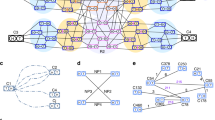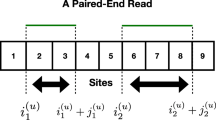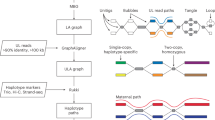Abstract
A generalization of interval graph is introduced for cosmid contig mapping of DNA. A graph is a tagged probe interval graph if its vertex set can be partitioned into two subsets of probes and nonprobes, and a closed interval can be assigned to each vertex such that two vertices are adjacent if and only if at least one of them is a probe and one end of its corresponding interval is contained in the interval corresponding to the other vertex. We show that tagged probe interval graphs are weakly triangulated graphs, hence are perfect graphs. For a tagged probe interval graph with a given partition, we give a chordal completion that is consistent to any interval completions with respect to the same vertex partition.
Similar content being viewed by others
References
K.S. Booth and S.G. Lueker, “Testing for consecutive ones property, interval graphs and planarity using pq-tree algorithms,” J. Comput. Syst. Sci., vol. 13, pp. 335-379, 1976.
A.V. Carrano, P.J. deJong, E. Branscomb, T. Slezak, and B.W. Watkins, “Constructing chromosome-and region-specific cosmid maps of the human genome,” Genome, vol. 31, pp. 1059-1065, 1989.
A. Coulson, J. Sulston, S. Brenner, and J. Karn, “Toward a physical map of the genome of the nematode,” Caenorhabditis Elegans. Proc. Natl. Acad. Sci. USa, vol. 83, pp. 7821-7825, 1987.
S.G. Fischer, E. Cayanis, J. Russo, I. Sunjevaric, B. Boukhgalter, X.L. Li, P. Zhang, P. Rothstein, M.T. Yu, D. Warburton, I.S. Edelman, and A. Efstratiadis, “Assembly of ordered contigs from yac-selected cosmids of human chromosome 13,” Genomics, vol. 21, pp. 525-537, 1994.
R.M. Gemmill, J.F. Coyle-Morris, F.D. McPeek Jr., L.F. Wara-Uribe, and F. Hecht, “Construction of long-range restriction maps in human DNAusing pulsed field gel electrophoresis,” Gene Anal. Technol., vol. 4, pp. 119-131, 1987.
M.C. Golumbic, Algorithmic Graph Theory and Perfect Graphs, Academic Press: New York, 1980.
R.B. Hayward, “Weakly triangulated graphs,” J. Comb. Theory (B), vol. 39, pp. 200-209, 1985.
J.L. Johnson and J.P. Sprinrad, “A polynomial time recognition algorithm for probe interval graphs,” Unpublished manuscript.
R. Karp, “Mapping of the genome: Some combinatorial problems arsing in molecular biology,” in Proc. 25 th Annual ACM Symp. on the Theory of Computing, New York, 1993, pp. 278-285. Association for Computing Machinery.
N. Korte and R.H. Möhring, “An incremental linear-time algorithm for recognizing interval graphs,” SIAM J. Comput., vol. 18, pp. 68-81, 1989.
F.R. McMorris, C. Wang, and P. Zhang, “On probe interval graphs,” Discrete Applied Mathematics, vol. 88, pp. 315-324, 1998.
M.V. Olson, E. Dutchik, M.Y. Graham, G.M. Brodeur, C. Helms, M. Frank, M. MacCollin, R. Acheinman, and T. Frand, “Random-clone strategy for genomic restriction mapping in yeast,” in Proc. Natl. Acad. Sci. USa, vol. 83, pp. 7826-7830, 1986.
F.S. Roberts, “Seven fundamental ideas in the application of combinatorics and graph theory in biological and social science,” in Applications of Combinatorics and Graph Theory in the Biological and Social Sciences, volume 17, of IMA Volumes in Mathematics and its Applications, F.S. Roberts (Ed.), Springer-Verlag, New York, 1989, pp. 1-37.
J. Setubal and J. Meidanis, Introduction to Computational Molecular Biology, PWS Publishing Company: Boston, MA, 1997.
L. Sheng, Some graph theoretic approaches to problems of the social and biological sciences: Social roles, phylogenetic trees, and physical mapping, PhD thesis, RUTCOR-Rutgers Center for Operations Research, Rutgers University, New Brunswick, New Jersey 08903, 1998.
L. Sheng, “Cycle free probe interval graphs,” Congressus Numerantium, vol. 140, pp. 33-42, 1999.
M.S. Waterman, Introduction to Computational Biology: Maps, Sequences and Genomes, Chapman Hall: London, 1995.
M.S. Waterman and J.R. Griggs, “Interval graphs and maps of DNA,” Bull. Math. Biol., vol. 48, pp. 189-195, 1986. P. Zhang, “Probe interval graphs and its applications to physical mapping of DNA,” Unpublished manuscript.
P. Zhang, E.A. Schon, S.F. Fischer, E. Cayanis, J. Weiss, S. Kistler, and P.E. Bourne, “An algorithm based on graph theory for the assembly of contigs in physical mapping of DNA,” CABIOs, vol. 10, pp. 309-317, 1994.
Author information
Authors and Affiliations
Rights and permissions
About this article
Cite this article
Sheng, L., Wang, C. & Zhang, P. Tagged Probe Interval Graphs. Journal of Combinatorial Optimization 5, 133–142 (2001). https://doi.org/10.1023/A:1009850020378
Issue Date:
DOI: https://doi.org/10.1023/A:1009850020378




